Top News
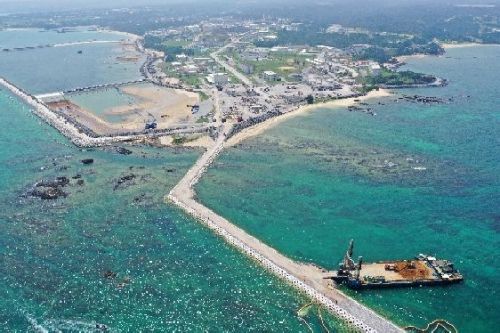
July 3, 2020 Ryukyu Shimpo
On July 2 a research group on Henoko, Okinawa (representative Masaaki Tateishi, professor emeritus at Niigata University), which is independently inspecting Futenma Replacement Facility construction in Henoko, Nago City associated with the relocation of U.S. Futenma Air Station, announced analysis results showing that if an earthquake having a seismic intensity of 1 or more occurs, there is a high risk that the seawalls will collapse due to the expanse of soft ground in Oura Bay. Even before this point, the potential that the seawalls may collapse has been identified. However, this time, even with calculations conducted in accordance with the Okinawa Defense Bureau’s (ODB’s) design requirements from which some data has been omitted, it has been identified that there is danger of the seawalls collapsing when an earthquake occurs.
The research group pointed out that “Forcing construction through in Henoko/Oura Bay is reckless”. Even the U.S. House Armed Services Subcommittee on Readiness, with the soft ground in mind, is showing concern about continuing FRF construction in relation to the National Defense Authorization Act (NDAA).
According to the research group, when the ODB examined ground improvement work on the soft ground, the stability of the seawalls was only calculated at normal times and the ODB explained that there was “no problem”. This time, the research group conducted “stability verification” ascertaining whether or not the seawalls would be safe in the case of an earthquake. The results made clear that even at a seismic intensity of 1 there would be risk of some seawalls breaking, and at a seismic intensity of 2 or more there would be risk of the majority of the outer peripheral seawalls surrounding the Oura Bay side collapsing.
It was measured that from 2010 to 2020 in Toyohara, Nago City, which neighbors Henoko, there were 60 earthquakes having a seismic intensity of 1 or more, 13 earthquakes having a seismic intensity of 2 or more, and 3 earthquakes having a seismic intensity of 3 or more. This would calculate to, over a 1-year period, the frequency of an earthquake having a seismic intensity of 1 or more being 6 times and a seismic intensity of 2 or more being 1 time, as well as a seismic intensity of 3 or more being 1 time every 3 years. The research group explained, “There is an extremely high chance that there will be an earthquake of the same scale during construction or when construction is completed”.
On July 2 the research group sent the research results to and requested confirmation from the Ministry of Defense, the ODB, and the technical investigative commission established by the ODB. In an interview with the Ryukyu Shimpo, Representative Tateishi mentioned that if the ODB alleges that the research group’s calculations are incorrect, the ODB will have to make calculations on its own and prove safety.
(English translation by T&CT and Erin Jones)
go to japanese
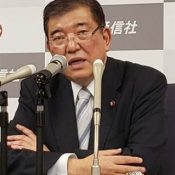
July 2, 2020 Ryukyu Shimpo
Tokyo—Former Defense Minister Shigeru Ishiba of the ruling Liberal Democratic Party spoke before a group of editorial writers from Kyodo News member newspapers on July 2. Ishiba commented on the relocation of U.S. Marine Corps Air Station Futenma to Henoko, Nago City and said, “I don’t believe that ‘this is it,’ I don’t think pushing [the plan] through is the only solution.” He indicated his intention to revisit the current relocation plan, which will entail examining the deterrence effect maintained by moving the U.S. Marines Corps to the new Henoko base and securing high-speed transports. Ishiba effectively cast doubt on the Abe administration’s persistent stance that “Henoko is the only solution,” and indicated he is willing to revisit the U.S.-Japan Status of Forces Agreement.
Polls show Ishiba is highly favored by the public to replace Prime Minister Shinzo Abe, whose term ends September 2021.
Given Tokyo’s recent decision to cancel the deployment of two Aegis Ashore missile defense systems due to unreasonable time, cost, and technical obstacles, Ishiba was asked whether the Futenma relocation plan will also be revisited. He responded, “I would agree that the time, cost and technical issues raised are all valid. However, I am not a marine engineer, so [I] really need to spend time verifying those points.”
Regarding the U.S.-Japan Status of Forces Agreement, which Okinawa Prefecture and the Association of Prefectural Governors have sought to amend, Ishiba said: “I don’t think we can further improve the operation of SOFA, but I’m convinced that needs to change. That’s how I felt when the helicopter crashed at Okinawa International University when I was Director General [of the Defense Agency].”
(English translation by T&CT and Monica Shingaki)
go to japanese
June 26 2020 Ryukyu Shimpo
By Yosuke Anri
Sueko Urasaki, 82, who came forward as the “trembling girl” in an image from the Battle of Okinawa, was, according to sources contacted on June 25, visited by a man who made accusatory remarks doubting her story. Urasaki has been avoiding contact with the outside for the past year. There have been other similar incidents involving the individuals who testified to the mass forced suicides in Zamami during the battle. The lasting inheritance of the Battle of Okinawa has become a topic of late, and someone familiar with the effort to suppress the testimonials of survivors raised the alarm bell, saying, “We cannot allow survivors to become hesitant, hindering the lessons to be passed down from the battle.”
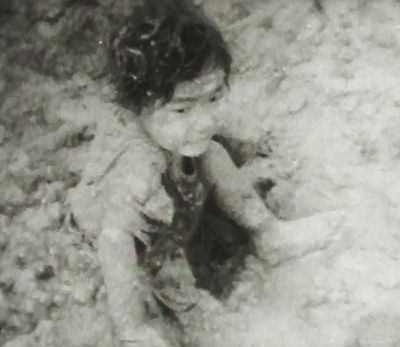
The trembling girl captured on film by the U.S. military (provided by the Okinawa Prefectural Archives)
According to a relative of Urasaki, the unknown man appeared at her home around August of last year. When Urasaki opened the door, he asked, “Are you Ms. Urasaki” before suddenly pulling close and saying “What are you trying to do?”
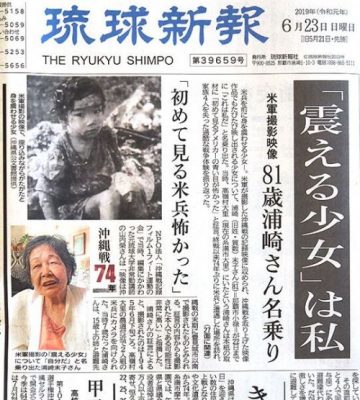
The 2019 Ryukyu Shimpo article “I am the trembling girl” in which Sueko Urasaki came forward as the girl in the picture
The Ryukyu Shimpo had reported in the June 23 morning edition of last year that Urasaki had come forward as the “trembling girl” in a photo taken by the U.S. military after the battle. Since the man was not an acquaintance, she felt, “He must have come to criticize me for appearing in the paper.” Terrified, she began refusing visitors and refrained from going outside. Her relatives reflected, “Reliving the Battle of Okinawa was painful. She felt that the man’s intention was to prevent her from spreading her story.”
There were also incidents of people trying to suppress stories about the Battle of Okinawa in the past as well. Harumi Miyagi, 70, an Okinawan women’s history researcher who compiled her mother’s notes about the compulsory suicides in Zamami, has received hate mail, threatening phone calls and unwanted visitors to her home.
Miyagi’s book was used as evidence when Japanese commanding officers from the battle filed a lawsuit against author Kenzaburo Oe and Iwanami Publishing for his descriptions of the compulsory suicides detailed in his book, Okinawa Notes, supporting their claim that, “They had given no such order.” Miyagi did not intend her writing to be supportive of the officers’ case, and released a new edition of her book that indicated “military orders” and the “compulsory nature” of the suicides.
In response to this move, supporters of the commanding officers called her place of work throughout June and July of 2006, demanding that “[She] be fired immediately” and sent her letters demanding she apologize to the former officers.
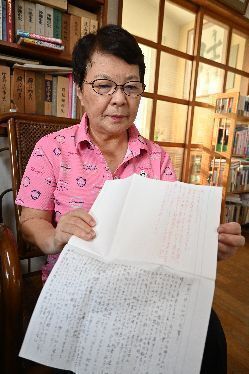
Harumi Miyagi holding one of the threatening letters sent to her place of work
In August of 2014, upon learning of the death of one of the former officers, a female journalist paid a visit to Miyagi in her home. They showed her an image of the former office crying as a “message”, then a man accompanying the reporter said, “You cannot write another book.” When the journalist was asked for comment by this newspaper, she said the purpose of the visit was for an “interview’ and that “showing her the image had no deeper meaning, it was just business as usual. I was certainly not a threat.” However Miyagi claims, “It was certainly intended to try and keep me silent.”
In September of 2007, when a citizens committee was held to demand that the Japanese government retract their decision to downplay the Japanese military’s role in mass suicides, a survivor of the suicides in Zamami was visited at home by two men clad entirely in black who demanded to know “Were you really there?” The survivor reflected, “I was unable to speak,” but the fear stuck with them. They said of that time, “They meant to scare me to keep me silent. I have not forgiven them, but I refrained from making the incident public so as not to further incite them.”
(English translation by T&CT and Sam Grieb)
go to japanese

July 3, 2020 Ryukyu Shimpo
A group of little terns, an endangered migratory bird, are breeding in a material storage area located in the southern part of Okinawa’s main island. The area is managed by Naha City and Okinawa Prefecture. In recent years, the birds have increasingly been breeding in this kind of open space as a result of the diminishing coastline due to landfill work. In 2014, the Ministry of the Environment established guidance on the protection and care of little tern breeding grounds. The breeding season continues until late July, so officials of Naha City, which manages the land, are planning to hold off on any work that would affect the area.
According to the prefectural Nature Conservation Division, approximately 80 birds have been confirmed in the material storage area. On July 2, parent birds were seen warming their eggs and carrying food to their chicks. Males with fish in their beaks courting females and pairs of mating birds were also seen.
The Nature Conservation Division received word of the breeding terns from the Wild Bird Society of Okinawa in early June. The material storage area is managed by the prefecture, but because the city of Naha manages the land, word was sent to the city as well. According to city representatives, there are plans to begin work such as enclosing the area and hydroseeding to prevent red soil runoff starting in August, but “we will see what is happening with the birds as we consider the timing.”
According to the chair of the Wild Bird Society of Okinawa, Masakuni Yamashiro, the little terns were observed breeding in the same location several years ago. “When you can predict that birds will nest in an area like this, you need to think carefully about a proactive response. Since the Ministry of the Environment released the guidance, the governmental response has improved,” he says. “If people get too close to the area, the breeding season can be a failure. I would like for people to leave the area alone.”
(English translation by T&CT and Ellen Huntley)
go to japanese

June 29, 2020 Ryukyu Shimpo
By Hideki Matsudo
A journal that belonged to an office worker from Mawashi village (now the Mawashi neighborhood of Naha) that details escaping to the southern part of Okinawa’s main island with his family during the Battle of Okinawa when he was 38, has been discovered. The man was Tatsusei Yogi (deceased 1988), an employee of Osaka Shosen Kaisha Lines’ (O.S.K. Lines) Naha Branch. In the journal, he details being evicted from his cave shelter and being directed to an evacuation site by the Imperial Japanese Army (IJA) in the midst of the U.S. army’s violent attack along with his wife Chiyo (35 years-old at the time), who was from Hawaii, two sons, two daughters, and his father Tatsuzen (75 years-old at the time), writing, “In addition to being told to leave the shelter, we were again ordered to evacuate to Tamagusuku.”
According to the Battle of Okinawa historians, this is the first primary written account of Okinawan’s evacuating during the bloody battle in the south of Okinawa’s main island.
Masaie Ishihara (emeritus professor Okinawa International University – OIU), a scholar of the Battle of O
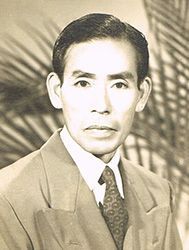
Tatsusei Yogi
kinawa, indicates, “The Japanese government covered up the evictions by claiming that the residents offered up the shelters due to need in the Imperial Japanese Army, and then conferred the status of combatant to residents who perished in the Battle of Okinawa, paid a survivor’s benefit to their families, and enshrined them at Yasukuni Shrine. However, according to Yogi’s journal, there is certainly no reading of it where the residents were acting like combatants and offered up the shelters to the military.”
The journal was written in a 12.5 cm by 7.5 cm Nippon Yusen sailor’s notebook. Tatsusei recorded his daily experiences including the U.S. military’s attacks and the IJA’s eviction orders from the 10/10 Air Raid on October 10, 1944 through June 20, 1945, when the U.S. assumed control of the island.
The journal includes entries such as one from May 26, 1945 in Makabe (Itoman City) he wrote “[We were] kicked out of our cave shelter,” and later that year on June 2 in Tamagusuku (Nanjo City) “[We were] ordered to evacuate the cave shelter,” detailing the experience of evacuating to southern Okinawa, and finally finding a cave shelter only to be ordered to leave by the IJA. It appears that the IJA was more concerned with their own safety than protecting Okinawans.
The journal also describes a lack of consistency between the IJA and police; after being directed to evacuate Tamagusuku in Nanjo and head to Makabe in Itoman, they were told to go back to Tamagusuku, causing them to roam an active battlefield. There are also entries describing food being shared, “Someone shared some horse meat with us,” (May 8, 1945), showing a group citizens who still managed to work together during an extreme situation.
The family at one point lost sight of the father, Tatsuzen, and their oldest daughter, eight-year-old Emi, while traveling from central Okinawa south. They were reunited with Emi 10 days later, but Tatsuzen was nowhere to be found. The eldest son, Takenobu (six years old at the time) died from illness in August, 1945.
The journal was edited by the second son, Takashi, 77, based on stories he heard from his parents, and had the journal translated into English and publicly released after Tatsusei’s death in 1988. The notebook the diary was recorded in was donated to the Okinawa Prefectural Peace Memorial Museum by relatives in October, 2007.
(English translation by T&CT and Sam Grieb)
go to japanese
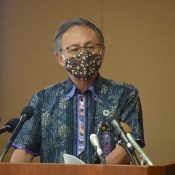
June 26, 2020 Ryukyu Shimpo
During a regular meeting on June 26, a reporter asked Governor Denny Tamaki what lessons can be learned from the Battle of Okinawa, referencing the governor’s remarks during the Okinawa Memorial Day ceremony which was held on June 23. The Okinawa governor responded, “In one word, ‘nuchi du takara’ (an Okinawan expression meaning life is precious.)” During the meeting, Governor Tamaki also answered questions about his Ie-Island-native mother’s experiences during WWII and her struggles after the war.
Governor Tamaki elaborated on his response and said, “Many Okinawan lives were lost and [we] need to take to heart the fact that 75 years later, [people] are still grieving. How can we set up an environment that prevents us from paying the human costs of war again? I intend to earnestly explore this question and put it in action.”
Over 1,500 local civilians and over 2,000 Japanese soldiers lost their lives in the battle at Ie Island (April 16-21, 1945) during the Battle of Okinawa. Governor Tamaki’s birth mother was just ten years old when she was caught in the war. She was saved by American soldiers and subsequently placed in an internment camp at Kerama Island. Governor Tamaki said of his mother, “Perhaps in my mother’s recollection the war was not so fierce, or perhaps she didn’t want to talk about what she remembered. Either way, she did not divulge any details of her memory of the war.”
He added, “I was told that life was much harder once the war ended. There were various after-effects, like an injury. I remember hearing my mother’s stories and even as a kid thinking to myself that healing these wounds is not easy.
Governor Tamaki was born to an Okinawan mother from Ie-Island and a U.S. Marine father. The late Katsu Chibana was his adoptive mother.
(English translation by T&CT and Monica Shingaki)
go to japanese
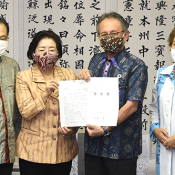
June 27, 2020 Ryukyu Shimpo
On June 26, Governor Denny Tamaki revealed a plan to form a new committee of experts this fiscal year to discuss the possibility of preserving and opening to the public the underground trenches built during the war under Shuri Castle and used as the headquarters of the Japanese military’s 32nd Army. His announcement was in response to Mikiko Shiroma, mayor, and Tomohiro Kudaka, head of the city council, of Naha and others who requested that the trenches be preserved and opened to the public. Governor Tamaki’s decision to form this committee will likely serve as a first step towards preserving the trenches that served as headquarters for the 32nd Army and opening them to the public.
Upon receiving the request, Governor Tamaki expressed the conventional view that “from the perspective of ensuring safety, given the possibility of falling rocks and lack of oxygen, it would be difficult to open [the trenches] to the public in their current state.” He then continued, “from the perspective of not allowing the war to be forgotten, I understand the importance of the role of the 32nd Army headquarter trenches in passing down history to the next generation. I hope to form a new committee to discuss how to preserve and open the trenches and transmit a message of peace, and consider the possibilities together with Naha City.” Vice Governor Kiichiro Jahana said, “I hope to see the committee discuss the ways in which [the trenches] can be preserved and opened to the public.”
When the committee will be established and when it will issue its conclusion have yet to be decided. Experts in civil engineering, the Battle of Okinawa, and various other fields will be selected to discuss the matter from different angles. The exact manner in which Naha City will be involved has not been decided yet. In 1997, the Prefectural Government formulated a “32nd Army Headquarter Trenches Preservation and Opening Master Plan”, but work towards maintenance and opening were suspended thereafter.
Mayor Shiroma et al. also requested that the governor call on the national government to gather human remains believed to remain in the trenches. “Even if it’s just a single bone, it’s important that it be returned to the surviving family members. If new materials concerning ungathered remains are obtained, I will provide them to the national government and endeavor to engage in dialogue with the national government to gather the remains,” said Governor Tamaki.
The 32nd Army was established in March 1944 for defense of Japan’s southwest islands. Construction of new headquarter trenches under Shuri Castle began in December 1944, and students who had been sheltering there were kicked out. The trenches span a total of one kilometer and are connected by five tunnels. It is said that more than one thousand soldiers, including General Mitsuru Ushijima and Lieutenant General Isamu Cho, resided in the trenches along with civilian employees of the military, students, women, and other Okinawans. As a base for the Japanese military, the trenches were fiercely attacked by the U.S. military, and on May 22, 1945, the Japanese military retreated to the south. These events all contributed to the tragic Battle of Okinawa in which Okinawan civilians too became victims of battle.
(English translation by T&CT and Sandi Aritza)
go to japanese
June 26, 2020 Ryukyu Shimpo
Doubts about the feasibility of relocating U.S. Marine Corps Air Station Futenma to Henoko, Nago City, has spread to the U.S.
The Readiness Subcommittee on the House Armed Services Committee has passed its portion of the Fiscal Year 2021 National Defense Authorization Act, and for the first time, concerns about the soft seabed and active earthquake fault lines present at the planned construction site in Henoko was addressed in the bill. The committee directed the Secretary of Defense to submit a report outlining the details of the sea-floor conditions at Henoko and to provide an assessment of the general environmental impacts.
Tokyo needs to halt the ongoing construction in Henoko and conduct a clear-eyed evaluation of the rationality of the project; it needs to stop wasting any further time and taxpayer money.
The new language adopted by the House Armed Services Subcommittee on Readiness may be credited to Gov. Denny Tamaki’s visit to Washington last October, where he met with U.S. lawmakers. The governor is entrusted by the Okinawan people with their representation, and his visit to the U.S. to directly plead for a solution to the military base issue carries a great significance.
It’s not just the governor’s U.S. visit; the combined lobbying efforts of opposition party members in the Japanese Diet and citizen groups demanding the re-examination of the Henoko relocation is moving the needle on policy making in the U.S.
However, whether this new language will be included in the finalized bill will depend on the whole of the House Armed Services Committee and its conference with the Senate. The Japanese government will doubtless increase its pressure on U.S. lawmakers to have the language removed and we must pay close attention to the conclusions of the conference.
The U.S. has long distanced itself from the Henoko construction issues, writing it off as a domestic issue for Japan to contend with. Its new concern and debate over the project is a drastic change. This indicates how much the presence of the soft seabed at Henoko fundamentally shatters the preconditions of the relocation plan.
The ground improvement work newly required at Henoko’s Oura Bay will drive up the total construction cost of the new base to about 930 billion yen, 2.7 times the original estimation, according to the Japanese government. The construction period has also increased to twelve years.
First and foremost, there is no precedence of conducting ground improvement work at 90-meters below sea level. Even if the government were to throw large amounts of time and taxpayer money at the project, there is no guarantee that the construction will be successful. Supposing the Henoko construction ends in success, the runway jutting out onto the cape is at risk of being hit by tsunamis, due to the possible presence of an active earthquake fault line at the site.
Signs of Henoko being an unsuitable location for a military base are mounting, including the ballooning budget and the complicated yet unprecedented construction work. Tokyo’s claim that Henoko is their only option, has already collapsed.
Defense Minister Taro Kono recently made a statement after suspending the Aegis Ashore ballistic missile system deployment and said, “Considering the cost and time it would require, I had no choice but to judge that pursuing the plan is not logical.” By this rationale, the construction at Henoko, which is also costly and time consuming, should be scrapped as well.
Regrets of having made wasteful investments can cause one to throw more time and money at the project to finish it. This is known as the sunk cost fallacy. Tokyo should not cling onto this failed project any longer.
(English translation by T&CT and Monica Shingaki)
go to japanese

June 25, 2020 Ryukyu Shimpo
By Wu Li Jun
Ishigaki’s decision to change the name of the Senkaku islands from “Tonoshiro” to “Tonoshiro Senkaku” has had an effect on their relationship with their sister city. Ishigaki and the city of Su’ao in Yinlan, Taiwan were on track to celebrate the 25th anniversary of becoming sister cities this year. Su’ao mayor Lee Ming-che told this paper that, “We were planning on an event to celebrate the 25th anniversary in September or October, however because of Ishigaki’s decision to change the name of the islands we are forced to cancel the event.”
Su’ao and Ishigaki had up until now been undertaking a variety of cultural exchange projects such as education and exchanging local specialties. Earlier this year in April when someone in Ishigaki contracted the coronavirus, Su’ao immediately sent healthcare workers a gift of masks and protective gear.
Lee commented, “Both Taiwan and Japan have their own opinions on the name change, but I do not want anyone to think these political stances has negatively affected the relationship built by the two cities,” adding that he intended for the cultural exchange program to continue.
As for the decision to cancel the 25th anniversary event, he said, “Mayor Yoshitaka Nakayama was planning to invite us to an event, however currently the fisherman in Su’ao are very angry with the name change, and so I do not think it would be suitable to hold an event this year.”
In response to Ishigaki’s name change, the government of Yinlan County submitted a proposal to Taiwan’s Ministry of the Interior to change their name of the Senkaku Islands from “Daiyoutai” to “Toucheng Daiyoutai” on June 22.
(English translaiton by T&CT and Sam Grieb)
go to japanese
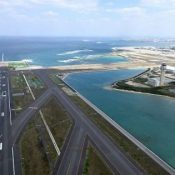
June 24, 2020 Ryukyu Shimpo
On June 24, the Okinawa Prefecture Department of Culture, Tourism and Sports announced that there were 44,000 visitors to the prefecture in May, a 94.7% (790,900 people) decrease compared to May 2019. This is the largest drop recorded, in both percentage and actual number of visitors and is the first time since September 1976 that the number of visitors has dropped below 50,000. The visitors in May were all domestic, making it the second consecutive month with zero international visitors.
According to prefectural representatives, the number of operating domestic flights was down 75.1% (3,223 flights) compared to the number planned for May, and down 60.5% (2,529 flights) in June. International flight suspensions continued in June and there are still no plans to resume operation of cruise ships.
Restrictions on travel between prefectures were lifted on June 19, so the number of domestic tourists is expected to recover from June.
Kazuhiro Toguchi, director of the Department of Culture, Tourism and Sports, says, “We are implementing protective measures as we work to revive the tourism industry.”
(English translation by T&CT and Ellen Huntley)
go to japanese
June 23, 2020 Ryukyu Shimpo
Seventy-five years have passed since the Battle of Okinawa, which took many precious Okinawan lives and destroyed the unique culture created by our forefathers. On this Okinawa Memorial Day, we want to inherit the experiences of the Battle of Okinawa with the testimony of battle survivors and messages sent to us from battle remains engraved in our hearts, and pledge to construct a foundation of peace-building.
Okinawans who experienced the Battle of Okinawa during their elementary school years are now in their 80s. Most of those who were mobilized to the battlefield as defense troops, “iron and blood imperial corps” student troops, and female student troops are now in their 90s. We have increasingly limited opportunities to hear testimony directly from the survivors.
We hope to put forth effort into opening our ears to the testimony of survivors in the little time we have left to do so, and come up with a new form of passing down these experiences on the basis of cumulative research on the Battle of Okinawa. In recent years, city and town histories and guidebooks about the Battle of Okinawa compiled with the participation of young researchers have been highly lauded.
The coronavirus pandemic, which has left the Okinawan economy and Okinawans’ lives hard hit, has also cast a shadow on the passing down of experiences of the Battle of Okinawa. The Okinawa Prefectural Peace Memorial Museum, Himeyuri Peace Museum, and Tsushima-maru Memorial Museum have all been forced to close their doors temporarily, and the time allocated to peace education in schools has also been cut. Memorial ceremonies across the prefecture have been downscaled or refrained from being held.
Although it is a shame that we have lost opportunities to honor the dead and learn about the Battle of Okinawa, we must not let these circumstances cause us to fall behind in our efforts to continue passing down experiences of the Battle of Okinawa.
In fact, the coronavirus pandemic has brought to the surface various challenges that we face in our attitude towards commemorating the dead and engaging in peace administration.
The Okinawa Prefectural Government initially announced that it would reduce the scale of the annual Okinawa Memorial Day ceremony and hold the ceremony at the National War Cemetery of Okinawa. Researchers specializing in study of the Battle of Okinawa objected to this plan. They expressed their concern that holding the ceremony at the National War Cemetery would support the position that civilian casualties were “martyrs” who sacrificed their lives for the emperor and the state.
Most Okinawans who have long commemorated the dead at the Cornerstone of Peace, the Konpaku Memorial Tower, and local memorial towers feel no affinity to the National Cemetery. The Prefectural Government ultimately moved the location of the ceremony back to the Peace Memorial Park, where it is normally held, but the event brought into question its attitude toward the sentiments of Battle of Okinawa survivors and victims.
Governor Denny Tamaki frankly addressed the concerns of Okinawans calling for a change in the ceremony venue saying, “I thought that the same sentiment would be communicated no matter where we prayed, so I didn’t think the venue was so important. Now I see that I hadn’t done my homework.” However, the governor’s expression of remorse does not signify an end to the issue, which shows that we are in danger of seeing commemoration of battle victims and peace administration becoming a shell of its former self. We want to see the Prefectural Government’s decision-making process in selecting the venue uncovered, analyzed, and used as a lesson for the future. Cities and towns must similarly take stock of their experience passing-down activities and the present state of war remains. Peace-building efforts should be a pillar of municipal administration.
We study the Battle of Okinawa in order to build peace. Okinawans have long taken a negative view of anything leading to war, based on the lesson gained from the tragic battle experiences that “the military does not protect civilians.” We have returned to the scorched aftermath of battle 75 years ago time and time again in order to uphold this belief.
The Battle of Okinawa is not a thing of the past. It serves as a valuable lesson for us living today. We must not forget that the experiences of the Battle of Okinawa give us a barometer in our peace-building efforts.
(English translation by T&CT and Sandi Aritza)
go to japanese












 Webcam(Kokusai Street)
Webcam(Kokusai Street)


